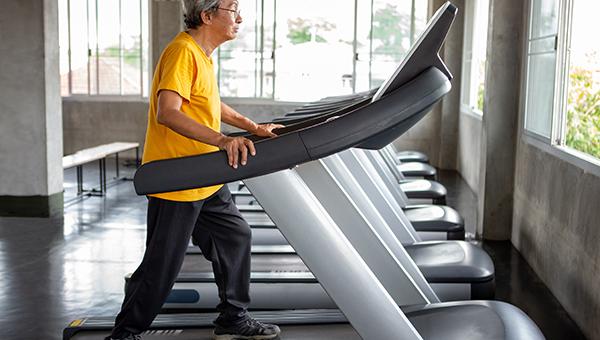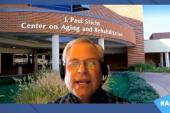Survey Addresses Cardiac Rehab Challenges and Future Directions
Pandemic experiences suggest that telehealth rehab services can be feasible and helpful to patients, says Ritu Thamman.

Cardiac rehab is underprescribed and underused, with only about one in five patients who are referred even completing the total prescribed number of sessions, a new survey shows.
Conducted by MedAxiom, an American College of Cardiology (ACC) company focused on performance improvement across cardiovascular organizations, the survey included respondents from 72 cardiac rehab programs in the United States (93% hospital-based).
More than half of those who responded offer a Phase III cardiac rehab program, 39% offer pulmonary rehab, and 28% offer supervised exercise therapy for PAD. While 95% of programs surveyed were staffed by exercise physiologists and 89% by RNs, only half had a dietician and a little more than one-third had respiratory therapists. More than half also said they use clerical staff to help out with patient throughput and scheduling.
“The survey is part of a fair amount of work that we are doing to understand what's happening and where the challenges lie,” said Ginger Biesbrock, PA-C, MPH (MedAxiom, Grand Rapids, MI), who authored the report. “We think that by starting there, we can build our tools and resources around that.”
“I think what's happened is we haven't gotten our processes in place to make it easy for our ordering providers to do the right thing,” Biesbrock added. “Some centers have put together an automated referral where it’s already checked, so the physician has to actually uncheck it if they don’t want the patient to go to rehab. That makes it easy and it helps with engagement, but it’s not widely used.”
Ritu Thamman, MD (University of Pittsburgh School of Medicine, PA), who commented on the survey findings for TCTMD, said automated referrals have been shown to be effective in places that use them.
“They can certainly make a dent and I think they are a good idea, but we know the problems with cardiac rehab uptake are multifactorial. Ultimately, somebody has to get the patient to the cardiac rehab center. Some people don't have cars, or they're older and they need someone to take them, or they’re younger women and they have so many responsibilities that they put themselves last,” she noted. “The other big issue here is money. For many of these patients, having to give a $30 co-pay each time is just not feasible.”
Thamman said one way to ease the financial problem could be to structure cardiac rehab similar to a gym membership with a monthly fee. For insurance companies, she added, it could be a win-win situation if they can offer cardiac rehab at an affordable price, which may lead to patients living longer and staying out of the hospital.
Biesbrock said future work needs to focus on gaining a better understand of the barriers behind all aspects of cardiac rehab: from physicians ordering it, to patients engaging in it and completing it as prescribed. Survey respondents reported that 54% of patients complete 21 to 30 sessions, 26% complete 11 to 20 sessions, and only 20% complete 31 to 40 sessions in a traditional program where three sessions a week for 12 to 18 weeks are typically prescribed.
According to Thamman, another aspect of ordering cardiac rehab that shouldn’t be overlooked is that it helps patients feel that their physician is invested in their health and wants them to improve.
“Similarly, when they go to cardiac rehab, they form relationships with the people who are administering the services,” she added. “These things help, but attrition rates are huge and they are a problem.”
COVID and Telehealth
As TCTMD reported in April 2020, when the COVID-19 pandemic shut down most cardiac rehab programs, the challenge fueled some to get creative with temporary care paradigms and patient outreach. In October 2020, the Centers for Medicare & Medicaid Services (CMS) temporarily added both cardiac rehab and intensive cardiac rehab to the list of approved telehealth services based on advocacy from the ACC and other stakeholders. In the new survey, only 13% of those who responded said they are offering virtual cardiac rehab services, but more than 50% said they would like to be able to offer them.
Thamman said the last year and a half of physicians gaining experience in telehealth makes it clear that these services work and benefit patients.
“I don’t know if CMS will leave it in place, but I think they should. Just like everything else, if patients can have access to rehab at their fingertips by having it on their phone, then they can do it forever,” she said. “Wearables are becoming more and more ubiquitous. Patients can still get the same interactions that they would get if they went in person to the rehab. So, I just don’t think telehealth should be a hindrance anymore.”
Biesbrock said the hope is that programs that have gone virtual will have robust outcomes data that can be used to appeal to CMS to reconsider their decision to make telehealth reimbursement only a temporary emergency measure tied to the pandemic.
L.A. McKeown is a Senior Medical Journalist for TCTMD, the Section Editor of CV Team Forum, and Senior Medical…
Read Full BioSources
MedAxiom. Survey report: cardiac rehab industry insights and best practices. Published on: September 14, 2021. Accessed on: September 27, 2021.
Disclosures
- Biesbrock is an employee of MedAxiom.
- Thamman reports no relevant conflicts of interest.





Comments